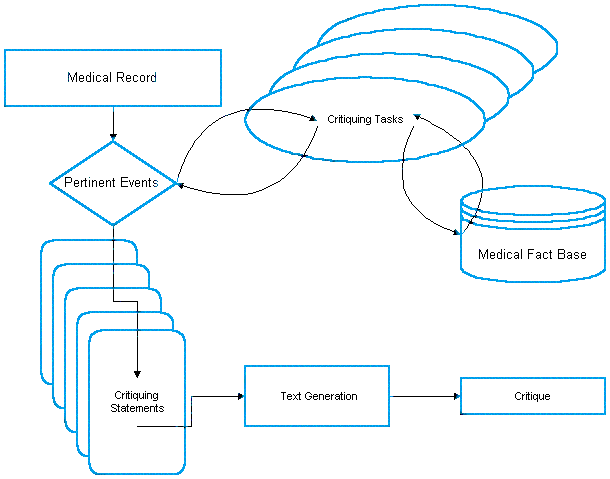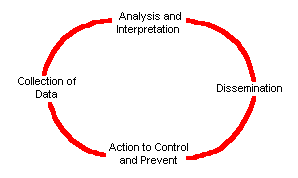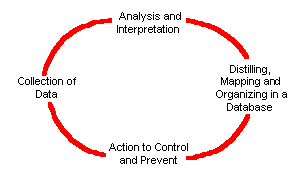
Interpretation of Results
This study showed that the occupational history was seldom used to screen a sample of patients in a primary care clinic. This is not a new finding. In Taking an Exposure History, published by the Agency for Toxic Substances and Disease Registry, reference is made to a study in which only 24% of 625 charts in a primary care practice had any mention of the patient’s occupation, and only 2% of the charts contained information about the patient’s occupational exposures.1
Our study also demonstrated that not only was there no exposure history; there was no exposure history when one was indicated. In 26 of 27 cases classified as possible and one of three case classified as probable occupational asthma, there was no mention of an exposure history. This could explain the lack of clinical recognition of occupational diseases, and it reveals a deficiency in the current paper-based patient record system. There exists no way to directly link data about the patient with data from the scientific literature.
Knowledge Coupling
The busy practitioner needs quick and easy access to specific, current information derived from the vast and rapidly growing body of medical knowledge. In 1991, MEDLINE indexed approximately 360,000 articles.2 Stand-alone decision support applications, CD-ROM databases, and modem connections to libraries and Internet sites can improve access to information, but they cannot meet the need for situation-specific information available at the time of the physician-patient encounter.3
Weed, the founder of the problem oriented medical record, calls this the knowledge coupling problem.4 The problem is caused by a combination of the limits of human memory and the explosion of medical knowledge.5, 6 To solve this problem, the clinician needs comprehensive medical knowledge that has been mapped to show the unique features of each diagnosis and management option. This guidance should be imbedded in the CPR that the clinician uses to describe the patient’s findings.4
Occupational diseases can be difficult to recognize because they often resemble nonoccupational diseases. The physicians in this study may have diagnosed their patients’ condition correctly as asthma, but they did not have access to the information about high risk occupations and tasks within those occupations necessary to take a relevant exposure history. What follows is a review of lessons learned in the field of epidemiology and medical informatics that could help to establish methods to improve the exposure history. These are methods that could strengthen the exposure history by increasing its positive predictive value. Without these methods, the exposure history will remain unlinked to medical research, and the deficiencies found in our study will continue.
Identifying Patients in High Risk Occupations
In our study of occupational asthma, we applied a method of knowledge coupling to identify patients at increased risk. This is similar to the idea of job exposure matrices that have been used in case-control studies. Based on an updated table of all agents known to cause occupational asthma with the associated jobs and job tasks, asthma patients at increased risk for a work-related etiology were identified. A job exposure matrix (JEM) can be defined as a cross-classification of job titles or industries with chemical exposures that allows the estimation of relative risk.7 JEMs have been criticized as a method that causes more non-differential misclassification than do questionnaires or experts.8 When occupational exposures are classified based on a proxy measure such as job title, then a non-differential or random misclassification of both cases and controls causes any true association between exposure and outcome to be diluted and underestimated.9 Epidemiologists at the National Cancer Institute have shown how the drawbacks of JEMs can be overcome by using a more specific industrial-occupational coding system that more accurately reflected the probability of exposure "across industries, over time, and within 4-digit occupational codes." 10
| Table 3.—Effects of Three Features of a Job-Exposure Matrix on Risk Estimates. | ||
| Feature Added to JEM | Possible Values | Effect on Odds Ratio: Using None, 1, 2 or All 3 Features |
| None | 1.47 |
|
| Probability of use of agent | low, medium or high | 2.47 |
| Use of more specific industrial-occupational coding system | additional digit in SIC & SOC* codes to differentiate occupations & indus-tries likely to be exposed to methylene chloride from those not exposed | 4.15 |
| Consideration of decade of predominant use | yes or no | 6.08 |
| *Standard Occupational Classification | ||
Table 3 shows how the odds ratio progressively moved away from the null with each additional feature that reduced misclassification in a case-control study to evaluate the association of methylene chloride and astrocytic brain cancer.
Increasing the Specificity of the Exposure History
Scientists at the National Cancer Institute have also identified a more efficient method for obtaining exposure histories in case-control studies.11 While interviewing the subject, the questions specific for the subject’s job or job tasks can be accessed, using a software application running on a personal computer. Branching questions specifically designed for over 40 different occupations have already been developed. The subject is questioned about each job task—whether or not it has been one of his or her duties. When the response is positive, then further questions about the task are asked. This enables the interviewer to ask pertinent, probing questions that are meant to uncover the determining factors of exposure dose and duration to potentially hazardous chemicals in that particular job task. There is no reason why this technique could not be adapted for clinical use to assist the primary care physician who is not knowledgeable in industrial hygiene and exposure assessment to take a more specific occupational history. This would fulfill one of the criteria needed in the strategy to increase the positive predictive value of the occupational history.
Lessons Learned about CPR Systems
Medical informatics is a new discipline that has taken on the task of knowledge coupling—bridging the knowledge gap between medical research and medical practice.12, 13 In order to provide situation-specific advice that can assist the physician at the time of the medical encounter, a method is required that will enable the physician to record the patient’s situation, i.e., findings, accurately without taking too much time.14 For occupational asthma, the most important finding is job title. However, other findings in the patient’s occupational history will need to be recorded in order to trigger relevant advice from the computer database. Examples of other specific findings are use of personal protective equipment, the specific years and the duration of the exposure, and the presence of asthma symptoms aggravated by work. Several medical informatics departments in universities around the world are working to develop a controlled medical terminology that is expressive enough to describe relevant distinctions in the patient’s condition; at the same time, this terminology must be unambiguous and formally defined so that it can be processed and stored in a computer database.15, 16, 17, 18
In 1991, The Institute of Medicine published a book that describes well the barriers and opportunities to the implementation of a computer-based patient record. The committee recognized that data entry by the health professionals was the "single greatest challenge in implementing the CPR."19 The committee also realized the importance of the role of medical terminology in serving as a common language, "Effective retrieval and use of information from patient records depend on consistency in naming or describing the same findings, clinical problems, procedures, drugs, and other data within a single patient record, across many patient records in a single record system, or in other systems that contain data relevant to the understanding and treatment of patient problems."20 The CPR that could assist physicians with an occupational history is feasible because the CPR is needed by all medical specialties, and in fact, by the whole healthcare system. At this early stage in the development of CPR systems, pilot projects addressing specific problems within specialties should be launched. However, the CPR will eventually become a common tool with a common language shared by clinicians from all specialties.
Structured data entry refers to data entry in which the concepts and their relationships have been formally defined and coded, a priori. An example of structured data entry is entering a search for a journal article in MEDLINE by picking an author’s name from a browse list. Structured data entry (SDE) can be viewed as a means to manage data proactively, thereby making possible real-time decision support and the aggregation of data for clinical research.21 It is SDE that triggers the critique from the medical knowledge base. When entered directly by the physician, SDE has the advantages over free text entry in improving the quality of the data and in triggering real-time decision support.22 The clinician must directly interact with the computer system at the time of the patient interview in order to receive effective critiquing of diagnosis and management decisions.23
Several prototypes of CPR systems using SDE and a customized controlled medical vocabulary have been developed to support patient care.24, 25, 26, 27, 28 These projects have demonstrated the importance of participation and collaboration in the development of a medical vocabulary that can be shared by clinicians, staff, and research scientists "The issues have much less to do with computational complexity, data-storage requirements, and lexicography than they do with social interactions and the nature of work."29 Similar lessons have been learned from projects that used CPR systems to implement practice guidelines that could positively influence physician behavior.30 Randomized controlled trials have repeatedly demonstrated that these systems can improve patient care while reducing the costs to provide that care when the systems are designed to provide patient specific reminders at the time of the encounter in such a way that the workflow of the clinic is facilitated. Again, data entry by the clinician at the point of care is an important requirement.
The Netherlands appears to be the world leader in establishing the CPR in primary care. As of June 1992, approximately 26% of general practitioners had adopted a paperless office.31 Coded data was mainly confined to laboratory results, medications and diagnoses, but efforts were underway to replace free text entry of history and physical findings with structured data entry.

- Fig 6.—The Critiquing Process
- (Adapted from Figure 2 in "A Model for Critiquing in Automated Medical Records"32)
HyperCritic, the software program that was developed to critique the hypertension management of primary care physicians, was linked to the CPR used by general practitioners in the Netherlands.. Two types of knowledge were needed in order to develop the HyperCritic program: (1) the medical knowledge about hypertension and its treatment with anti-hypertensive drugs, and (2) the knowledge about when and how to critique. Figure 6 is a diagram of the critiquing process used by the HyperCritic program. HyperCritic is an active form of decision support in which the program continually monitors the patient record for particular events upon which to act. There is also a passive, user-directed form of decision support that depends on the user’s recognition of a question that is then formulated as a query of the knowledge base.33 The philosophy behind the critiquing approach to decision support is that an "intelligent database" can help the physician manage information by making it easy to store, access and use.34 The computer software is part of a cooperative system to "support the strengths and complement the weaknesses of the clinician’s problem-solving."35
Bridging Epidemiology and Clinical Practice
The CPR could serve to bridge the knowledge gap between clinical practice and epidemiological research. The effect would be to establish a surveillance cycle of data collection, consolidation and interpretation, dissemination, and action to control and prevent.36 (See Figure 7.) From the standpoint of the epidemiologist, the CPR system will represent continuous and accurate data capture for analytical studies of morbidity. From the point of view of the physician, the CPR system will function as a source of comprehensive information about the specific health risks of the subpopulations to which the patient belongs.37, 38 Data collected by physicians in the CPR will be analyzed and interpreted by epidemiologists. The information will then be disseminated by means of the CPR to the physicians so that actions to control and prevent can occur.

Fig 7.—The Surveillance Cycle.
Figure 8 shows this surveillance cycle with a modification necessary for the distillation of the knowledge in the epidemiology literature and its dissemination by means of the CPR. One of the lessons learned in the development of knowledge-based systems to support evidence and population-based medicine was the importance of evidence collection and summarization. "The work of extracting, abstracting, and commenting is highly skilled and labor-intensive, and expensive."39 The knowledge must also be mapped and coded in a database so that it can be processed and stored by computers. For occupational diseases, one of the important questions is how to best classify and code jobs and job tasks. Standard job classification systems such as the Dictionary of Occupational Titles40 could be used as a starting point, but, for the purposes of occupational medicine, more specific codes will be needed in order to reduce random misclassification.

Fig 8.—Modified Surveillance Cycle.
Conclusions
The primary question addressed by this study was whether or not the currently used paper-based patient record system supported the physician in taking an exposure history when one was indicated. If the study had found that exposure histories were taken when indicated, then there would be no reason to improve the system with CPR. However, the study did find evidence of a deficiency in the present system—only three of 30 charts of patients classified as possible or probable OA contained documentation of an exposure history. Therefore, this study failed to disprove the hypothesis that the paper-based system does not support effective screening of OA. Effective screening depends upon the availability of a screening test that has high positive predictive value. The use of a screening test with low positive predictive value wastes clinic resources, e.g., physicians’ time, and therefore, is not used. The CPR could provide a means to improve the positive predictive value of the exposure history so that more occupational asthma could be recognized and prevented. Research has shown that the CPR, when properly designed and implemented to support the workflow of the clinic, does have the requirements necessary to meet the deficiencies of the paper-based system. Mainly, the CPR could provide situation-specific decision support at the time of the clinical encounter by using methods adapted from JEMs and computer-assisted interviews that were developed to improve the exposure histories obtained in case-control studies. Unlike the paper-based system, the computerized system could give the physician access to automatic critiquing that would turn the exposure history into a knowledge-based tool and an effective screening test.
A secondary question addressed by this study is the degree to which job exposure matrices can improve the recognition of OA. In other words, what proportion of asthma patients have jobs that can be linked with an agent known to cause occupational asthma? In this small study of 96 patients coded as having asthma, 87 had chart documentation supporting that diagnosis. Of these, 26 patients with a job-agent link (23 classified as possible OA and three classified as probable OA) could have been recognized as having an increased risk for occupational asthma by using a computer-based JEM. In fact, only three of the cases (two probable and one possible) were identified as OA by practitioners at GHC based on the presence of a documented exposure history. A larger study to address this question could be done. By using an electronic database of patients that contained both diagnosis and occupational codes, the proportion of asthma patients with job-agent links could be studied in larger and different populations. The findings of the current study would suggest that the proportion may be substantial, and this lends further support to the value of a CPR system.
It has been suggested that such a CPR system could function as a knowledge coupler to bridge the gap between research and clinical practice. For this to occur, new efforts will be required to prepare the knowledge uncovered by research scientists so that it can be disseminated by means of databases connected to the CPR. What is the most efficient way to do the work of distilling, mapping and organizing in a database the population research that will be linked to the computer-based patient record and help to improve the health of that population? This research question could be addressed in pilot projects designed to improve the recognition of occupational asthma in an occupational medicine clinic similar to the projects done at universities to implement knowledge-based systems in AIDS clinics.24, 26 There now exists a need for research scientists interested in the problem of knowledge mapping and knowledge coupling .The unassisted human memory is inadequate to meet the complex tasks of managing AIDS patients or diagnosing occupational diseases in the information age. The computer-based patient record system is a new tool that will function as an extension of the human memory and will provide us with the means to deal with the complexities of modern occupational and environmental medicine.
| Abstract | Slides | Introduction | Discussion |